Dissertation on Evaluating Communication Gaps in Abraj Energy Services
VerifiedAdded on 2023/06/07
|99
|23019
|217
Thesis and Dissertation
AI Summary
This dissertation explores the communication gap within Abraj Energy Services, focusing on the impact of effective communication on employee retention and productivity. The study reviews existing literature on management communication, cross-cultural communication, and organizational trust, highlighting the importance of bridging the gap between head office and field employees. It outlines the research methodology, including quantitative and qualitative data analysis, and presents findings related to communication challenges within the company. The research investigates the causes and effects of communication gaps, such as lack of trust, clarity, and effective technology use. The dissertation concludes with recommendations for improving communication practices within Abraj Energy Services, emphasizing the need for strategic communication planning, enhanced training, and the adoption of modern communication technologies. The research also touches upon the company's background, its operational structure, and its commitment to employee motivation and sustainable growth.
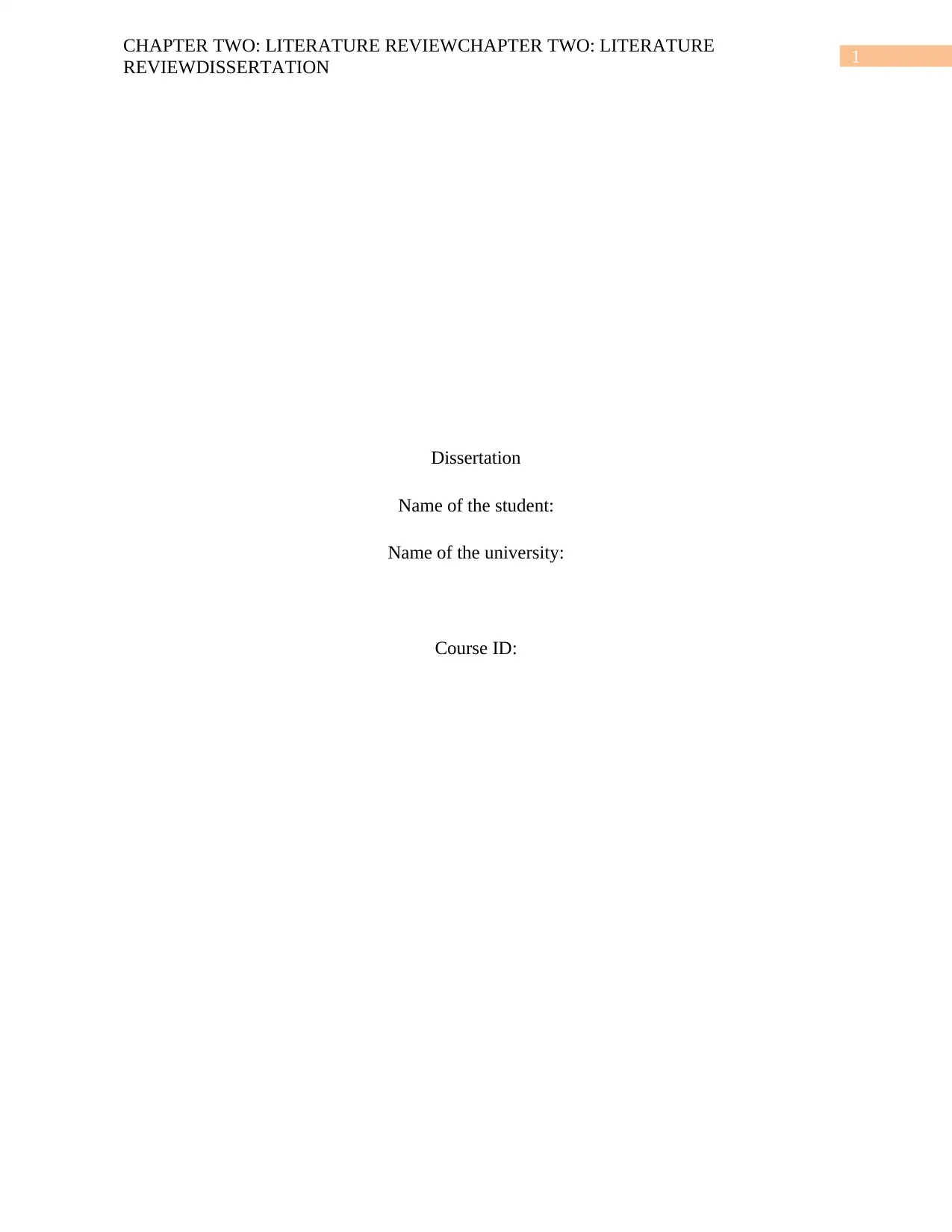
1
CHAPTER TWO: LITERATURE REVIEWCHAPTER TWO: LITERATURE
REVIEWDISSERTATION
Dissertation
Name of the student:
Name of the university:
Course ID:
CHAPTER TWO: LITERATURE REVIEWCHAPTER TWO: LITERATURE
REVIEWDISSERTATION
Dissertation
Name of the student:
Name of the university:
Course ID:
Paraphrase This Document
Need a fresh take? Get an instant paraphrase of this document with our AI Paraphraser
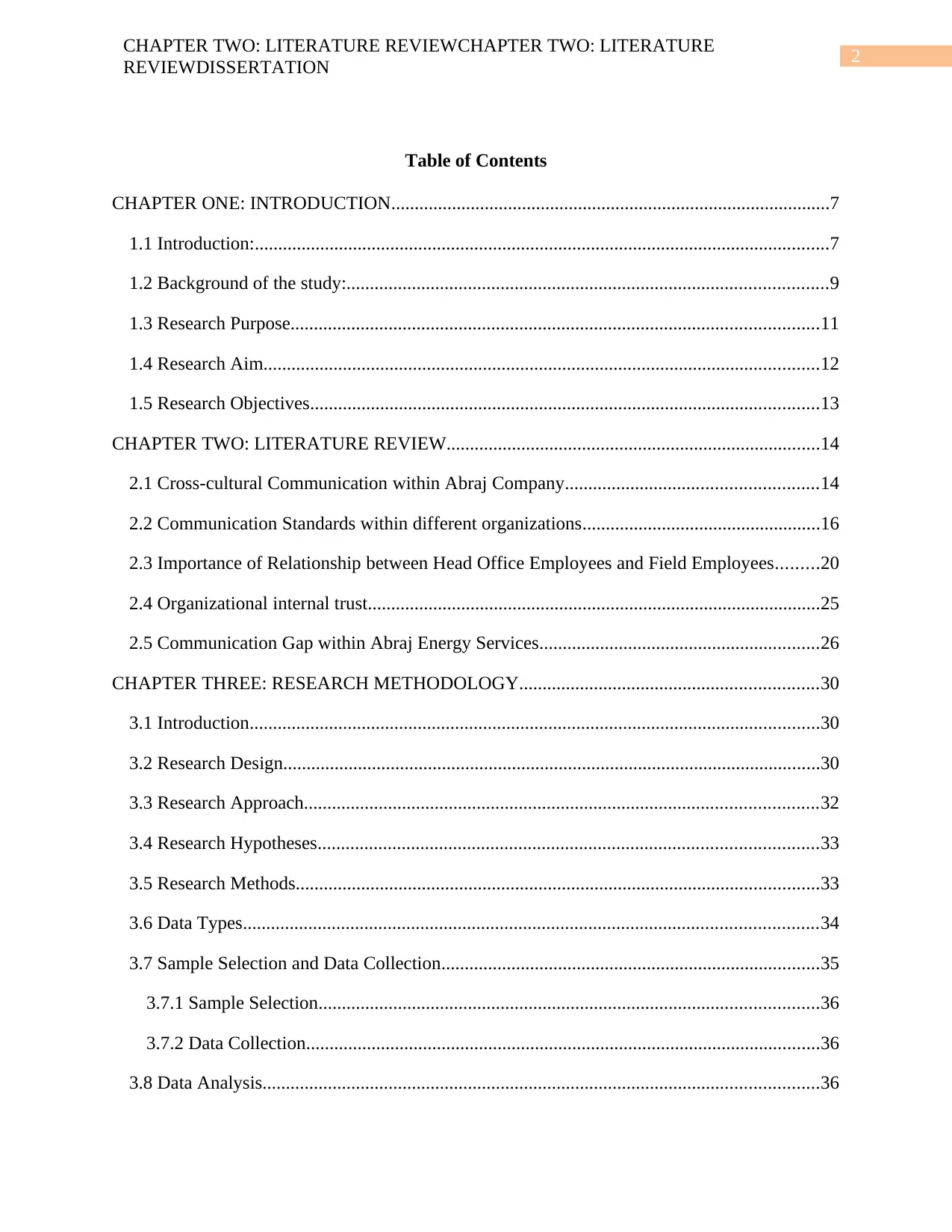
2
CHAPTER TWO: LITERATURE REVIEWCHAPTER TWO: LITERATURE
REVIEWDISSERTATION
Table of Contents
CHAPTER ONE: INTRODUCTION..............................................................................................7
1.1 Introduction:...........................................................................................................................7
1.2 Background of the study:.......................................................................................................9
1.3 Research Purpose.................................................................................................................11
1.4 Research Aim.......................................................................................................................12
1.5 Research Objectives.............................................................................................................13
CHAPTER TWO: LITERATURE REVIEW................................................................................14
2.1 Cross-cultural Communication within Abraj Company......................................................14
2.2 Communication Standards within different organizations...................................................16
2.3 Importance of Relationship between Head Office Employees and Field Employees.........20
2.4 Organizational internal trust.................................................................................................25
2.5 Communication Gap within Abraj Energy Services............................................................26
CHAPTER THREE: RESEARCH METHODOLOGY................................................................30
3.1 Introduction..........................................................................................................................30
3.2 Research Design...................................................................................................................30
3.3 Research Approach..............................................................................................................32
3.4 Research Hypotheses...........................................................................................................33
3.5 Research Methods................................................................................................................33
3.6 Data Types...........................................................................................................................34
3.7 Sample Selection and Data Collection.................................................................................35
3.7.1 Sample Selection...........................................................................................................36
3.7.2 Data Collection..............................................................................................................36
3.8 Data Analysis.......................................................................................................................36
CHAPTER TWO: LITERATURE REVIEWCHAPTER TWO: LITERATURE
REVIEWDISSERTATION
Table of Contents
CHAPTER ONE: INTRODUCTION..............................................................................................7
1.1 Introduction:...........................................................................................................................7
1.2 Background of the study:.......................................................................................................9
1.3 Research Purpose.................................................................................................................11
1.4 Research Aim.......................................................................................................................12
1.5 Research Objectives.............................................................................................................13
CHAPTER TWO: LITERATURE REVIEW................................................................................14
2.1 Cross-cultural Communication within Abraj Company......................................................14
2.2 Communication Standards within different organizations...................................................16
2.3 Importance of Relationship between Head Office Employees and Field Employees.........20
2.4 Organizational internal trust.................................................................................................25
2.5 Communication Gap within Abraj Energy Services............................................................26
CHAPTER THREE: RESEARCH METHODOLOGY................................................................30
3.1 Introduction..........................................................................................................................30
3.2 Research Design...................................................................................................................30
3.3 Research Approach..............................................................................................................32
3.4 Research Hypotheses...........................................................................................................33
3.5 Research Methods................................................................................................................33
3.6 Data Types...........................................................................................................................34
3.7 Sample Selection and Data Collection.................................................................................35
3.7.1 Sample Selection...........................................................................................................36
3.7.2 Data Collection..............................................................................................................36
3.8 Data Analysis.......................................................................................................................36
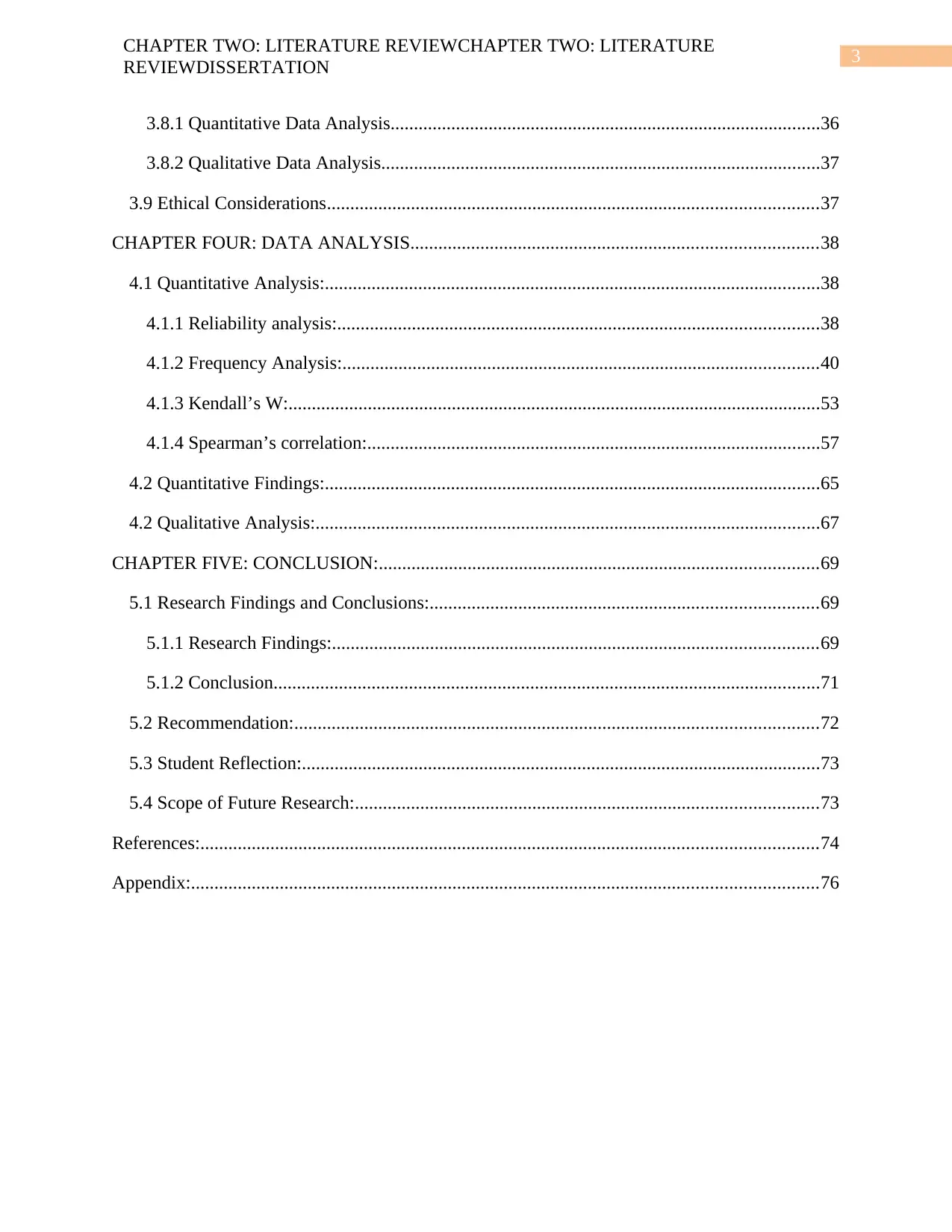
3
CHAPTER TWO: LITERATURE REVIEWCHAPTER TWO: LITERATURE
REVIEWDISSERTATION
3.8.1 Quantitative Data Analysis............................................................................................36
3.8.2 Qualitative Data Analysis..............................................................................................37
3.9 Ethical Considerations.........................................................................................................37
CHAPTER FOUR: DATA ANALYSIS.......................................................................................38
4.1 Quantitative Analysis:..........................................................................................................38
4.1.1 Reliability analysis:.......................................................................................................38
4.1.2 Frequency Analysis:......................................................................................................40
4.1.3 Kendall’s W:..................................................................................................................53
4.1.4 Spearman’s correlation:.................................................................................................57
4.2 Quantitative Findings:..........................................................................................................65
4.2 Qualitative Analysis:............................................................................................................67
CHAPTER FIVE: CONCLUSION:..............................................................................................69
5.1 Research Findings and Conclusions:...................................................................................69
5.1.1 Research Findings:........................................................................................................69
5.1.2 Conclusion.....................................................................................................................71
5.2 Recommendation:................................................................................................................72
5.3 Student Reflection:...............................................................................................................73
5.4 Scope of Future Research:...................................................................................................73
References:....................................................................................................................................74
Appendix:......................................................................................................................................76
CHAPTER TWO: LITERATURE REVIEWCHAPTER TWO: LITERATURE
REVIEWDISSERTATION
3.8.1 Quantitative Data Analysis............................................................................................36
3.8.2 Qualitative Data Analysis..............................................................................................37
3.9 Ethical Considerations.........................................................................................................37
CHAPTER FOUR: DATA ANALYSIS.......................................................................................38
4.1 Quantitative Analysis:..........................................................................................................38
4.1.1 Reliability analysis:.......................................................................................................38
4.1.2 Frequency Analysis:......................................................................................................40
4.1.3 Kendall’s W:..................................................................................................................53
4.1.4 Spearman’s correlation:.................................................................................................57
4.2 Quantitative Findings:..........................................................................................................65
4.2 Qualitative Analysis:............................................................................................................67
CHAPTER FIVE: CONCLUSION:..............................................................................................69
5.1 Research Findings and Conclusions:...................................................................................69
5.1.1 Research Findings:........................................................................................................69
5.1.2 Conclusion.....................................................................................................................71
5.2 Recommendation:................................................................................................................72
5.3 Student Reflection:...............................................................................................................73
5.4 Scope of Future Research:...................................................................................................73
References:....................................................................................................................................74
Appendix:......................................................................................................................................76
⊘ This is a preview!⊘
Do you want full access?
Subscribe today to unlock all pages.

Trusted by 1+ million students worldwide
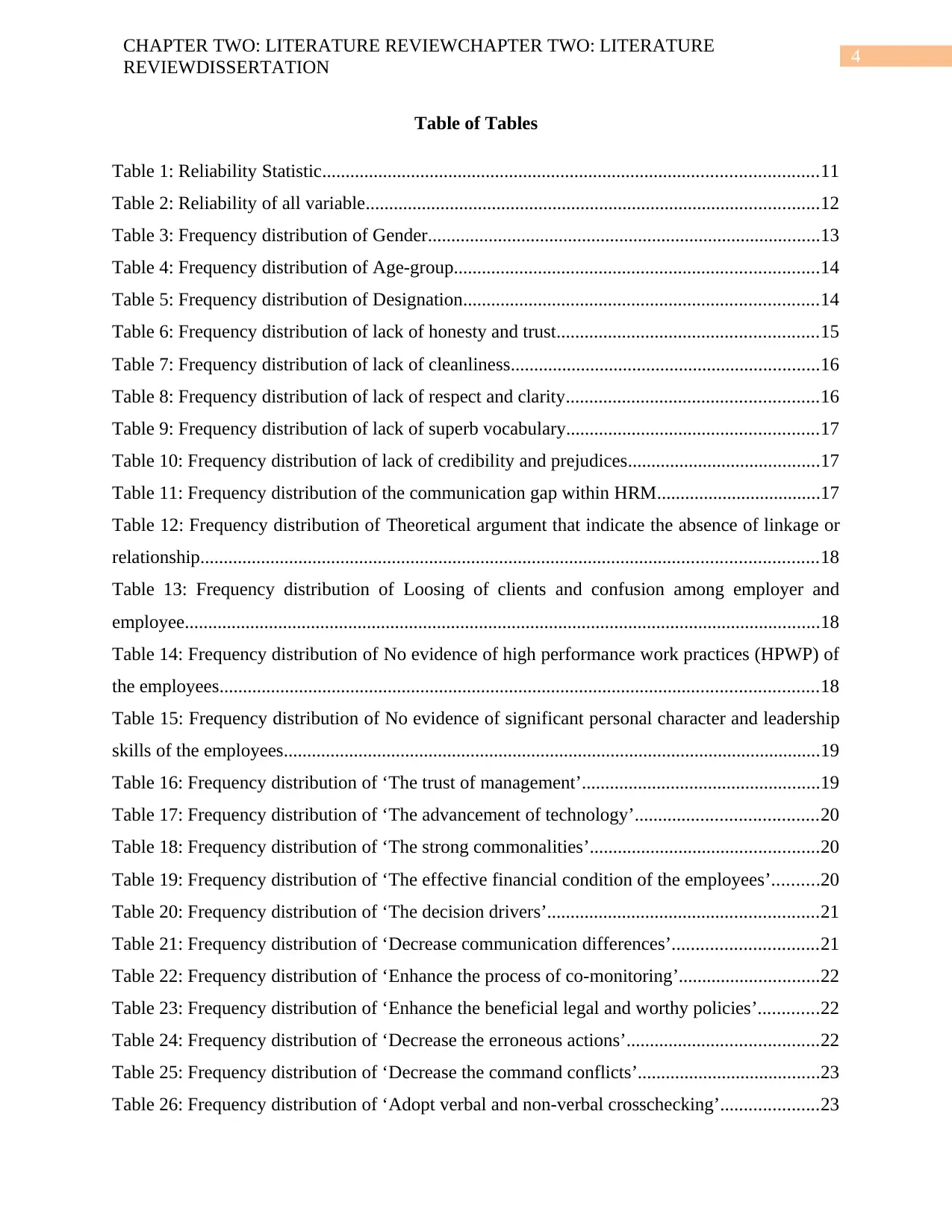
4
CHAPTER TWO: LITERATURE REVIEWCHAPTER TWO: LITERATURE
REVIEWDISSERTATION
Table of Tables
Table 1: Reliability Statistic..........................................................................................................11
Table 2: Reliability of all variable.................................................................................................12
Table 3: Frequency distribution of Gender....................................................................................13
Table 4: Frequency distribution of Age-group..............................................................................14
Table 5: Frequency distribution of Designation............................................................................14
Table 6: Frequency distribution of lack of honesty and trust........................................................15
Table 7: Frequency distribution of lack of cleanliness..................................................................16
Table 8: Frequency distribution of lack of respect and clarity......................................................16
Table 9: Frequency distribution of lack of superb vocabulary......................................................17
Table 10: Frequency distribution of lack of credibility and prejudices.........................................17
Table 11: Frequency distribution of the communication gap within HRM...................................17
Table 12: Frequency distribution of Theoretical argument that indicate the absence of linkage or
relationship....................................................................................................................................18
Table 13: Frequency distribution of Loosing of clients and confusion among employer and
employee........................................................................................................................................18
Table 14: Frequency distribution of No evidence of high performance work practices (HPWP) of
the employees................................................................................................................................18
Table 15: Frequency distribution of No evidence of significant personal character and leadership
skills of the employees...................................................................................................................19
Table 16: Frequency distribution of ‘The trust of management’...................................................19
Table 17: Frequency distribution of ‘The advancement of technology’.......................................20
Table 18: Frequency distribution of ‘The strong commonalities’.................................................20
Table 19: Frequency distribution of ‘The effective financial condition of the employees’..........20
Table 20: Frequency distribution of ‘The decision drivers’..........................................................21
Table 21: Frequency distribution of ‘Decrease communication differences’...............................21
Table 22: Frequency distribution of ‘Enhance the process of co-monitoring’..............................22
Table 23: Frequency distribution of ‘Enhance the beneficial legal and worthy policies’.............22
Table 24: Frequency distribution of ‘Decrease the erroneous actions’.........................................22
Table 25: Frequency distribution of ‘Decrease the command conflicts’.......................................23
Table 26: Frequency distribution of ‘Adopt verbal and non-verbal crosschecking’.....................23
CHAPTER TWO: LITERATURE REVIEWCHAPTER TWO: LITERATURE
REVIEWDISSERTATION
Table of Tables
Table 1: Reliability Statistic..........................................................................................................11
Table 2: Reliability of all variable.................................................................................................12
Table 3: Frequency distribution of Gender....................................................................................13
Table 4: Frequency distribution of Age-group..............................................................................14
Table 5: Frequency distribution of Designation............................................................................14
Table 6: Frequency distribution of lack of honesty and trust........................................................15
Table 7: Frequency distribution of lack of cleanliness..................................................................16
Table 8: Frequency distribution of lack of respect and clarity......................................................16
Table 9: Frequency distribution of lack of superb vocabulary......................................................17
Table 10: Frequency distribution of lack of credibility and prejudices.........................................17
Table 11: Frequency distribution of the communication gap within HRM...................................17
Table 12: Frequency distribution of Theoretical argument that indicate the absence of linkage or
relationship....................................................................................................................................18
Table 13: Frequency distribution of Loosing of clients and confusion among employer and
employee........................................................................................................................................18
Table 14: Frequency distribution of No evidence of high performance work practices (HPWP) of
the employees................................................................................................................................18
Table 15: Frequency distribution of No evidence of significant personal character and leadership
skills of the employees...................................................................................................................19
Table 16: Frequency distribution of ‘The trust of management’...................................................19
Table 17: Frequency distribution of ‘The advancement of technology’.......................................20
Table 18: Frequency distribution of ‘The strong commonalities’.................................................20
Table 19: Frequency distribution of ‘The effective financial condition of the employees’..........20
Table 20: Frequency distribution of ‘The decision drivers’..........................................................21
Table 21: Frequency distribution of ‘Decrease communication differences’...............................21
Table 22: Frequency distribution of ‘Enhance the process of co-monitoring’..............................22
Table 23: Frequency distribution of ‘Enhance the beneficial legal and worthy policies’.............22
Table 24: Frequency distribution of ‘Decrease the erroneous actions’.........................................22
Table 25: Frequency distribution of ‘Decrease the command conflicts’.......................................23
Table 26: Frequency distribution of ‘Adopt verbal and non-verbal crosschecking’.....................23
Paraphrase This Document
Need a fresh take? Get an instant paraphrase of this document with our AI Paraphraser
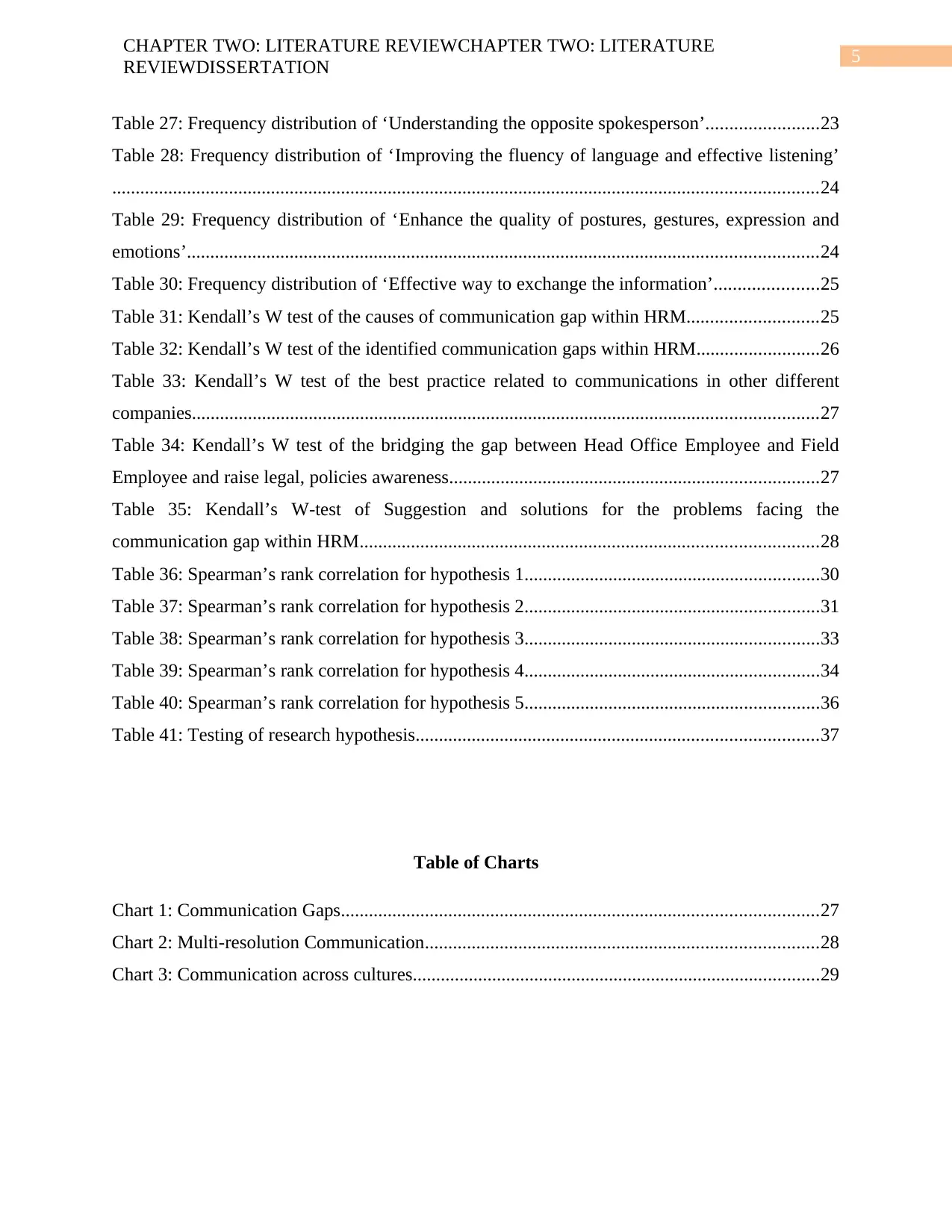
5
CHAPTER TWO: LITERATURE REVIEWCHAPTER TWO: LITERATURE
REVIEWDISSERTATION
Table 27: Frequency distribution of ‘Understanding the opposite spokesperson’........................23
Table 28: Frequency distribution of ‘Improving the fluency of language and effective listening’
.......................................................................................................................................................24
Table 29: Frequency distribution of ‘Enhance the quality of postures, gestures, expression and
emotions’.......................................................................................................................................24
Table 30: Frequency distribution of ‘Effective way to exchange the information’......................25
Table 31: Kendall’s W test of the causes of communication gap within HRM............................25
Table 32: Kendall’s W test of the identified communication gaps within HRM..........................26
Table 33: Kendall’s W test of the best practice related to communications in other different
companies......................................................................................................................................27
Table 34: Kendall’s W test of the bridging the gap between Head Office Employee and Field
Employee and raise legal, policies awareness...............................................................................27
Table 35: Kendall’s W-test of Suggestion and solutions for the problems facing the
communication gap within HRM..................................................................................................28
Table 36: Spearman’s rank correlation for hypothesis 1...............................................................30
Table 37: Spearman’s rank correlation for hypothesis 2...............................................................31
Table 38: Spearman’s rank correlation for hypothesis 3...............................................................33
Table 39: Spearman’s rank correlation for hypothesis 4...............................................................34
Table 40: Spearman’s rank correlation for hypothesis 5...............................................................36
Table 41: Testing of research hypothesis......................................................................................37
Table of Charts
Chart 1: Communication Gaps......................................................................................................27
Chart 2: Multi-resolution Communication....................................................................................28
Chart 3: Communication across cultures.......................................................................................29
CHAPTER TWO: LITERATURE REVIEWCHAPTER TWO: LITERATURE
REVIEWDISSERTATION
Table 27: Frequency distribution of ‘Understanding the opposite spokesperson’........................23
Table 28: Frequency distribution of ‘Improving the fluency of language and effective listening’
.......................................................................................................................................................24
Table 29: Frequency distribution of ‘Enhance the quality of postures, gestures, expression and
emotions’.......................................................................................................................................24
Table 30: Frequency distribution of ‘Effective way to exchange the information’......................25
Table 31: Kendall’s W test of the causes of communication gap within HRM............................25
Table 32: Kendall’s W test of the identified communication gaps within HRM..........................26
Table 33: Kendall’s W test of the best practice related to communications in other different
companies......................................................................................................................................27
Table 34: Kendall’s W test of the bridging the gap between Head Office Employee and Field
Employee and raise legal, policies awareness...............................................................................27
Table 35: Kendall’s W-test of Suggestion and solutions for the problems facing the
communication gap within HRM..................................................................................................28
Table 36: Spearman’s rank correlation for hypothesis 1...............................................................30
Table 37: Spearman’s rank correlation for hypothesis 2...............................................................31
Table 38: Spearman’s rank correlation for hypothesis 3...............................................................33
Table 39: Spearman’s rank correlation for hypothesis 4...............................................................34
Table 40: Spearman’s rank correlation for hypothesis 5...............................................................36
Table 41: Testing of research hypothesis......................................................................................37
Table of Charts
Chart 1: Communication Gaps......................................................................................................27
Chart 2: Multi-resolution Communication....................................................................................28
Chart 3: Communication across cultures.......................................................................................29
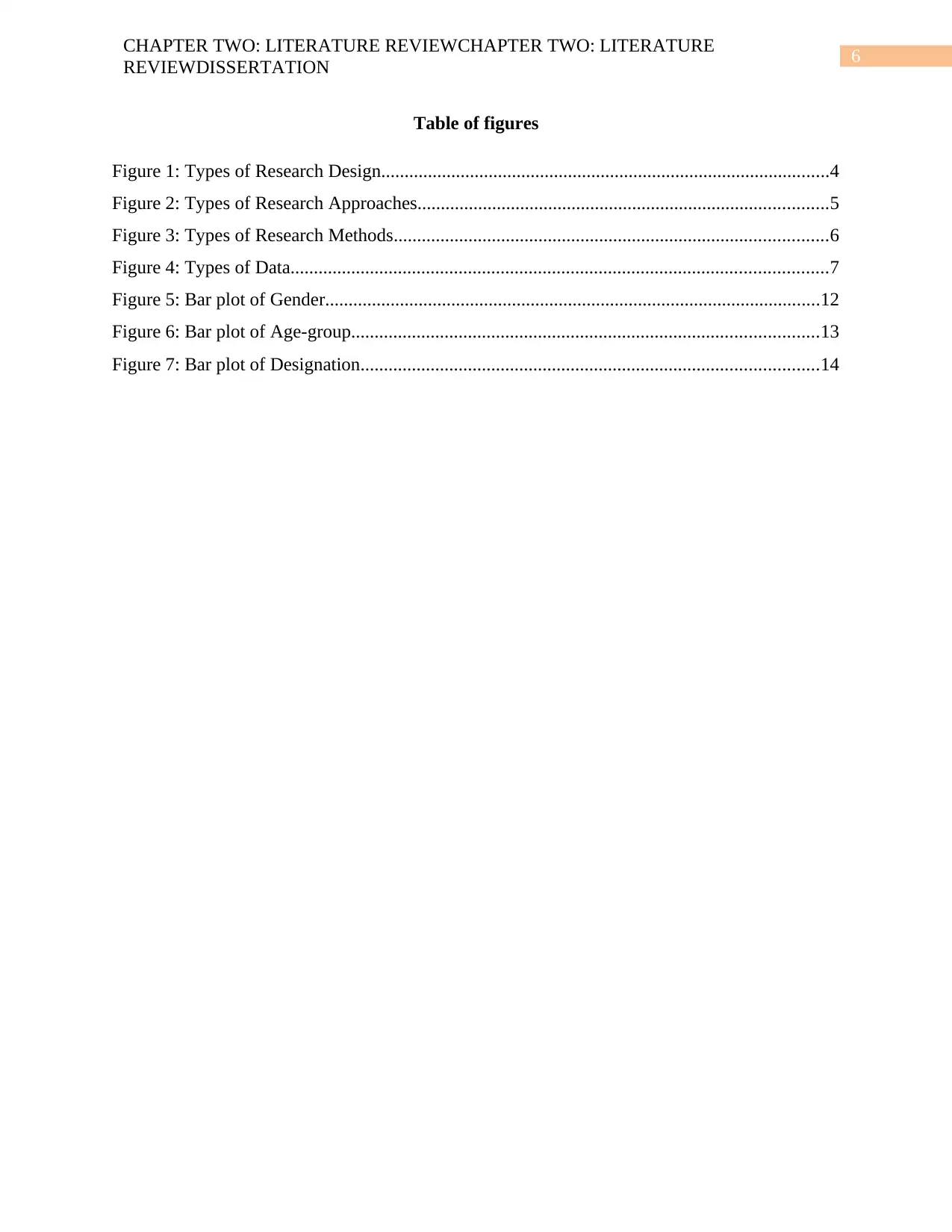
6
CHAPTER TWO: LITERATURE REVIEWCHAPTER TWO: LITERATURE
REVIEWDISSERTATION
Table of figures
Figure 1: Types of Research Design................................................................................................4
Figure 2: Types of Research Approaches........................................................................................5
Figure 3: Types of Research Methods.............................................................................................6
Figure 4: Types of Data...................................................................................................................7
Figure 5: Bar plot of Gender..........................................................................................................12
Figure 6: Bar plot of Age-group....................................................................................................13
Figure 7: Bar plot of Designation..................................................................................................14
CHAPTER TWO: LITERATURE REVIEWCHAPTER TWO: LITERATURE
REVIEWDISSERTATION
Table of figures
Figure 1: Types of Research Design................................................................................................4
Figure 2: Types of Research Approaches........................................................................................5
Figure 3: Types of Research Methods.............................................................................................6
Figure 4: Types of Data...................................................................................................................7
Figure 5: Bar plot of Gender..........................................................................................................12
Figure 6: Bar plot of Age-group....................................................................................................13
Figure 7: Bar plot of Designation..................................................................................................14
⊘ This is a preview!⊘
Do you want full access?
Subscribe today to unlock all pages.

Trusted by 1+ million students worldwide
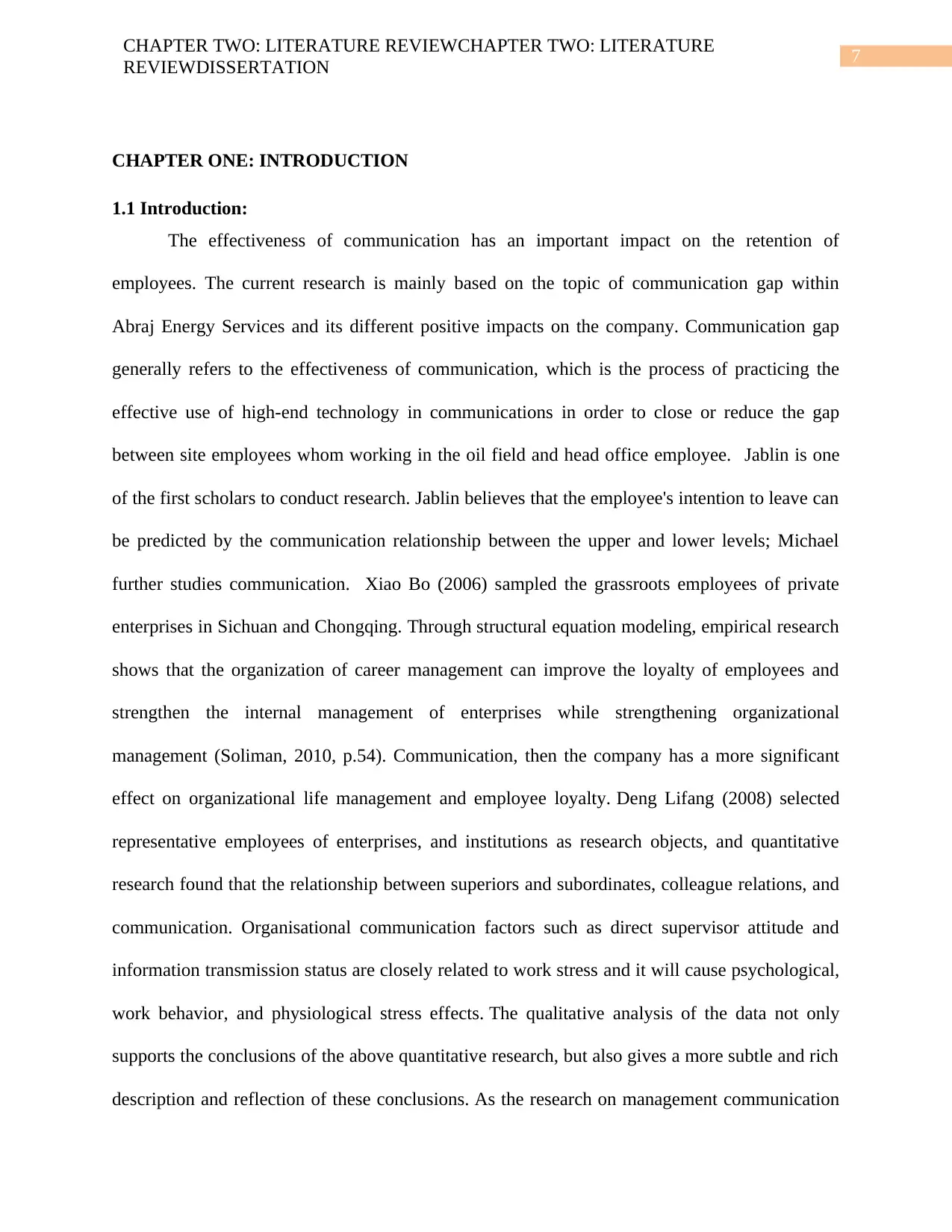
7
CHAPTER TWO: LITERATURE REVIEWCHAPTER TWO: LITERATURE
REVIEWDISSERTATION
CHAPTER ONE: INTRODUCTION
1.1 Introduction:
The effectiveness of communication has an important impact on the retention of
employees. The current research is mainly based on the topic of communication gap within
Abraj Energy Services and its different positive impacts on the company. Communication gap
generally refers to the effectiveness of communication, which is the process of practicing the
effective use of high-end technology in communications in order to close or reduce the gap
between site employees whom working in the oil field and head office employee. Jablin is one
of the first scholars to conduct research. Jablin believes that the employee's intention to leave can
be predicted by the communication relationship between the upper and lower levels; Michael
further studies communication. Xiao Bo (2006) sampled the grassroots employees of private
enterprises in Sichuan and Chongqing. Through structural equation modeling, empirical research
shows that the organization of career management can improve the loyalty of employees and
strengthen the internal management of enterprises while strengthening organizational
management (Soliman, 2010, p.54). Communication, then the company has a more significant
effect on organizational life management and employee loyalty. Deng Lifang (2008) selected
representative employees of enterprises, and institutions as research objects, and quantitative
research found that the relationship between superiors and subordinates, colleague relations, and
communication. Organisational communication factors such as direct supervisor attitude and
information transmission status are closely related to work stress and it will cause psychological,
work behavior, and physiological stress effects. The qualitative analysis of the data not only
supports the conclusions of the above quantitative research, but also gives a more subtle and rich
description and reflection of these conclusions. As the research on management communication
CHAPTER TWO: LITERATURE REVIEWCHAPTER TWO: LITERATURE
REVIEWDISSERTATION
CHAPTER ONE: INTRODUCTION
1.1 Introduction:
The effectiveness of communication has an important impact on the retention of
employees. The current research is mainly based on the topic of communication gap within
Abraj Energy Services and its different positive impacts on the company. Communication gap
generally refers to the effectiveness of communication, which is the process of practicing the
effective use of high-end technology in communications in order to close or reduce the gap
between site employees whom working in the oil field and head office employee. Jablin is one
of the first scholars to conduct research. Jablin believes that the employee's intention to leave can
be predicted by the communication relationship between the upper and lower levels; Michael
further studies communication. Xiao Bo (2006) sampled the grassroots employees of private
enterprises in Sichuan and Chongqing. Through structural equation modeling, empirical research
shows that the organization of career management can improve the loyalty of employees and
strengthen the internal management of enterprises while strengthening organizational
management (Soliman, 2010, p.54). Communication, then the company has a more significant
effect on organizational life management and employee loyalty. Deng Lifang (2008) selected
representative employees of enterprises, and institutions as research objects, and quantitative
research found that the relationship between superiors and subordinates, colleague relations, and
communication. Organisational communication factors such as direct supervisor attitude and
information transmission status are closely related to work stress and it will cause psychological,
work behavior, and physiological stress effects. The qualitative analysis of the data not only
supports the conclusions of the above quantitative research, but also gives a more subtle and rich
description and reflection of these conclusions. As the research on management communication
Paraphrase This Document
Need a fresh take? Get an instant paraphrase of this document with our AI Paraphraser

8
CHAPTER TWO: LITERATURE REVIEWCHAPTER TWO: LITERATURE
REVIEWDISSERTATION
began to quantify, the focus of its indicator system began to increase (Den Hartog, 2013,
pp.1637-1665). Cheng Zhichao (2005) divided the effectiveness of communication into two
categories of indicators, 10 specific indicators: one is the effect indicators, including consistency,
clarity, content, fluency and credibility. The other is efficiency indicators, including timeliness,
complexity, confusability, ratio of use and rework rate. Wang Wei and Song Yan (2007)
proposed an index evaluation system for the effectiveness of virtual enterprise organization
communication, which simplified Cheng Zhichao's system as follows: performance indicators
include consistency, reliability and innovation; efficiency indicators include timeliness and ratio
Use and consumption. Management communication began to focus on the study of team
performance. Mei Hong, (2008) analyzed the factors affecting the effectiveness of organizational
management communication for leaders and teachers and students in the organization. The study
found that communication satisfaction and open communication have positive effects on
improving college performance (Den Hartog, 2013, pp.1637-1665).
Yang Yaqin (2008) simulates the decision-making task of island survival. Through two
rounds of experiments, it is concluded that the degree of communication has an impact on the
team's mission performance. Under the condition of sufficient communication, the accuracy of
team decision-making tasks is higher than that under the condition of insufficient
communication. At the same time, in terms of performance, the degree of communication has an
impact on the satisfaction of individual decision-making. Under the condition of sufficient
communication, the satisfaction of team members in personal decision-making is lower than that
under the condition of insufficient communication, that is, communication is sufficient to make
team members more agreeable on team decision-making (Kesler, 1995, pp.229-252). With the
deepening of management communication research, researchers encounter more and more
CHAPTER TWO: LITERATURE REVIEWCHAPTER TWO: LITERATURE
REVIEWDISSERTATION
began to quantify, the focus of its indicator system began to increase (Den Hartog, 2013,
pp.1637-1665). Cheng Zhichao (2005) divided the effectiveness of communication into two
categories of indicators, 10 specific indicators: one is the effect indicators, including consistency,
clarity, content, fluency and credibility. The other is efficiency indicators, including timeliness,
complexity, confusability, ratio of use and rework rate. Wang Wei and Song Yan (2007)
proposed an index evaluation system for the effectiveness of virtual enterprise organization
communication, which simplified Cheng Zhichao's system as follows: performance indicators
include consistency, reliability and innovation; efficiency indicators include timeliness and ratio
Use and consumption. Management communication began to focus on the study of team
performance. Mei Hong, (2008) analyzed the factors affecting the effectiveness of organizational
management communication for leaders and teachers and students in the organization. The study
found that communication satisfaction and open communication have positive effects on
improving college performance (Den Hartog, 2013, pp.1637-1665).
Yang Yaqin (2008) simulates the decision-making task of island survival. Through two
rounds of experiments, it is concluded that the degree of communication has an impact on the
team's mission performance. Under the condition of sufficient communication, the accuracy of
team decision-making tasks is higher than that under the condition of insufficient
communication. At the same time, in terms of performance, the degree of communication has an
impact on the satisfaction of individual decision-making. Under the condition of sufficient
communication, the satisfaction of team members in personal decision-making is lower than that
under the condition of insufficient communication, that is, communication is sufficient to make
team members more agreeable on team decision-making (Kesler, 1995, pp.229-252). With the
deepening of management communication research, researchers encounter more and more

9
CHAPTER TWO: LITERATURE REVIEWCHAPTER TWO: LITERATURE
REVIEWDISSERTATION
challenges, but opportunities also coexist. Researchers have found that in order to better conduct
research on management communication and make it more effective in enterprise management,
it is necessary to conduct research from a multi-dimensional perspective. It is necessary to
expand the scope of research and must conduct in-depth quantitative research. Since Taylor’s
scientific management, management communication research has gone from “administrative
communication” to “interpersonal communication”, from “vertical communication” to
“horizontal communication” to “network communication”, and “single task communication”
to "All-round knowledge sharing communication." Since the end of the last century, with the
application and development of network information technology in management communication,
management communication ideas have undergone important changes and encountered new
challenges. With the development of modern management theory, it gradually presents a trend of
more knowledge, flatness, virtualization, humanization, networking, globalization, and
management communication theory. Driven by many new trends, management communication
theory research is bound to enter a new stage (Den Hartog, 2013, pp.1637-1665).
1.2 Background of the study:
The study focus on communication gap within Abraj Energy Services Company, which is
an efficient and bridging the gap between head office and site employee as it will increase the
productivity of the site employee as they are the majority in the company and directly effect in
the production. Nowadays, management communication research has achieved many positive
results, such as preliminary research on the principles, definitions, types and modes of
communication; preliminary establishment of the important position of management
communication in enterprise management; for different aspects such as people's theory and
CHAPTER TWO: LITERATURE REVIEWCHAPTER TWO: LITERATURE
REVIEWDISSERTATION
challenges, but opportunities also coexist. Researchers have found that in order to better conduct
research on management communication and make it more effective in enterprise management,
it is necessary to conduct research from a multi-dimensional perspective. It is necessary to
expand the scope of research and must conduct in-depth quantitative research. Since Taylor’s
scientific management, management communication research has gone from “administrative
communication” to “interpersonal communication”, from “vertical communication” to
“horizontal communication” to “network communication”, and “single task communication”
to "All-round knowledge sharing communication." Since the end of the last century, with the
application and development of network information technology in management communication,
management communication ideas have undergone important changes and encountered new
challenges. With the development of modern management theory, it gradually presents a trend of
more knowledge, flatness, virtualization, humanization, networking, globalization, and
management communication theory. Driven by many new trends, management communication
theory research is bound to enter a new stage (Den Hartog, 2013, pp.1637-1665).
1.2 Background of the study:
The study focus on communication gap within Abraj Energy Services Company, which is
an efficient and bridging the gap between head office and site employee as it will increase the
productivity of the site employee as they are the majority in the company and directly effect in
the production. Nowadays, management communication research has achieved many positive
results, such as preliminary research on the principles, definitions, types and modes of
communication; preliminary establishment of the important position of management
communication in enterprise management; for different aspects such as people's theory and
⊘ This is a preview!⊘
Do you want full access?
Subscribe today to unlock all pages.

Trusted by 1+ million students worldwide

10
CHAPTER TWO: LITERATURE REVIEWCHAPTER TWO: LITERATURE
REVIEWDISSERTATION
organization Conducting comparative research; conducting in-depth research on management
communication methods and techniques; conducting preliminary research on network
communication; and conducting in-depth research on organizations and teams. At present,
although the research on business management communication has made great achievements,
many universities around the world have opened management communication courses, but
today's management communication theory is still in a state of disorder, unable to form an
organic system and complete (Kesler, 1995, pp.229-252). The system is mainly characterized by
the lack of strategic level of enterprise management communication research, the difficulty of
unifying many theoretical viewpoints, and the lag of management communication based on
network information systems. Faced with the inseparable background of management and
communication, the existing management communication theory obviously cannot adapt to the
needs of modern enterprise management, and it is crucial to have a new management
communication theory at the strategic level that is compatible with current enterprise
management. The management practice of enterprises has an important influence and far-
reaching guiding significance.
Company overview
Abraj Energy Services was founded in May 2006 and is growing rapidly within the
industry. In addition, the company handles a variety of engineering services based on well
services and well construction regionally and internationally. In addition, the company has made
great efforts to ensure safe and accident-free drilling operations, bringing higher customer
satisfaction to the company (Abrajoman.com, 2016).
CHAPTER TWO: LITERATURE REVIEWCHAPTER TWO: LITERATURE
REVIEWDISSERTATION
organization Conducting comparative research; conducting in-depth research on management
communication methods and techniques; conducting preliminary research on network
communication; and conducting in-depth research on organizations and teams. At present,
although the research on business management communication has made great achievements,
many universities around the world have opened management communication courses, but
today's management communication theory is still in a state of disorder, unable to form an
organic system and complete (Kesler, 1995, pp.229-252). The system is mainly characterized by
the lack of strategic level of enterprise management communication research, the difficulty of
unifying many theoretical viewpoints, and the lag of management communication based on
network information systems. Faced with the inseparable background of management and
communication, the existing management communication theory obviously cannot adapt to the
needs of modern enterprise management, and it is crucial to have a new management
communication theory at the strategic level that is compatible with current enterprise
management. The management practice of enterprises has an important influence and far-
reaching guiding significance.
Company overview
Abraj Energy Services was founded in May 2006 and is growing rapidly within the
industry. In addition, the company handles a variety of engineering services based on well
services and well construction regionally and internationally. In addition, the company has made
great efforts to ensure safe and accident-free drilling operations, bringing higher customer
satisfaction to the company (Abrajoman.com, 2016).
Paraphrase This Document
Need a fresh take? Get an instant paraphrase of this document with our AI Paraphraser
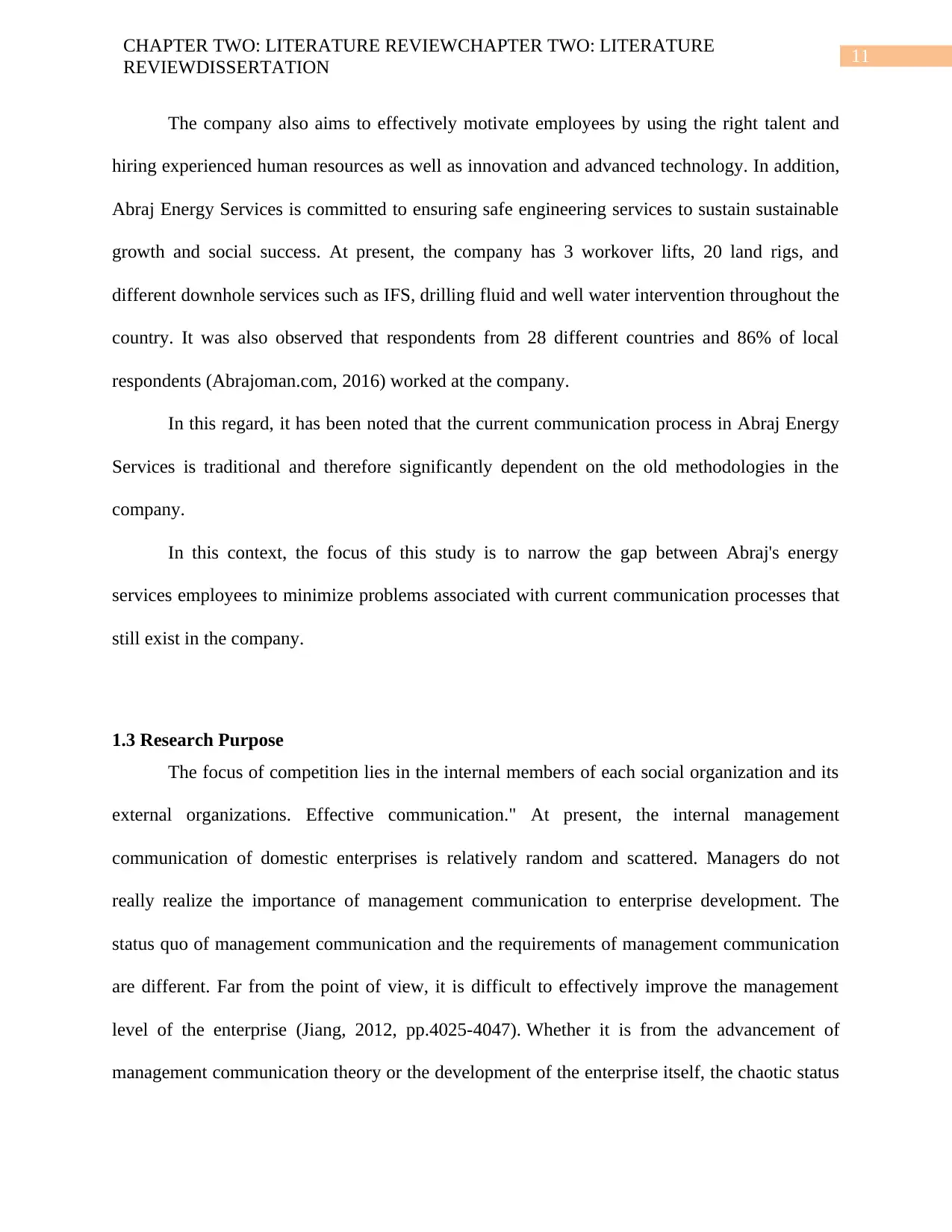
11
CHAPTER TWO: LITERATURE REVIEWCHAPTER TWO: LITERATURE
REVIEWDISSERTATION
The company also aims to effectively motivate employees by using the right talent and
hiring experienced human resources as well as innovation and advanced technology. In addition,
Abraj Energy Services is committed to ensuring safe engineering services to sustain sustainable
growth and social success. At present, the company has 3 workover lifts, 20 land rigs, and
different downhole services such as IFS, drilling fluid and well water intervention throughout the
country. It was also observed that respondents from 28 different countries and 86% of local
respondents (Abrajoman.com, 2016) worked at the company.
In this regard, it has been noted that the current communication process in Abraj Energy
Services is traditional and therefore significantly dependent on the old methodologies in the
company.
In this context, the focus of this study is to narrow the gap between Abraj's energy
services employees to minimize problems associated with current communication processes that
still exist in the company.
1.3 Research Purpose
The focus of competition lies in the internal members of each social organization and its
external organizations. Effective communication." At present, the internal management
communication of domestic enterprises is relatively random and scattered. Managers do not
really realize the importance of management communication to enterprise development. The
status quo of management communication and the requirements of management communication
are different. Far from the point of view, it is difficult to effectively improve the management
level of the enterprise (Jiang, 2012, pp.4025-4047). Whether it is from the advancement of
management communication theory or the development of the enterprise itself, the chaotic status
CHAPTER TWO: LITERATURE REVIEWCHAPTER TWO: LITERATURE
REVIEWDISSERTATION
The company also aims to effectively motivate employees by using the right talent and
hiring experienced human resources as well as innovation and advanced technology. In addition,
Abraj Energy Services is committed to ensuring safe engineering services to sustain sustainable
growth and social success. At present, the company has 3 workover lifts, 20 land rigs, and
different downhole services such as IFS, drilling fluid and well water intervention throughout the
country. It was also observed that respondents from 28 different countries and 86% of local
respondents (Abrajoman.com, 2016) worked at the company.
In this regard, it has been noted that the current communication process in Abraj Energy
Services is traditional and therefore significantly dependent on the old methodologies in the
company.
In this context, the focus of this study is to narrow the gap between Abraj's energy
services employees to minimize problems associated with current communication processes that
still exist in the company.
1.3 Research Purpose
The focus of competition lies in the internal members of each social organization and its
external organizations. Effective communication." At present, the internal management
communication of domestic enterprises is relatively random and scattered. Managers do not
really realize the importance of management communication to enterprise development. The
status quo of management communication and the requirements of management communication
are different. Far from the point of view, it is difficult to effectively improve the management
level of the enterprise (Jiang, 2012, pp.4025-4047). Whether it is from the advancement of
management communication theory or the development of the enterprise itself, the chaotic status
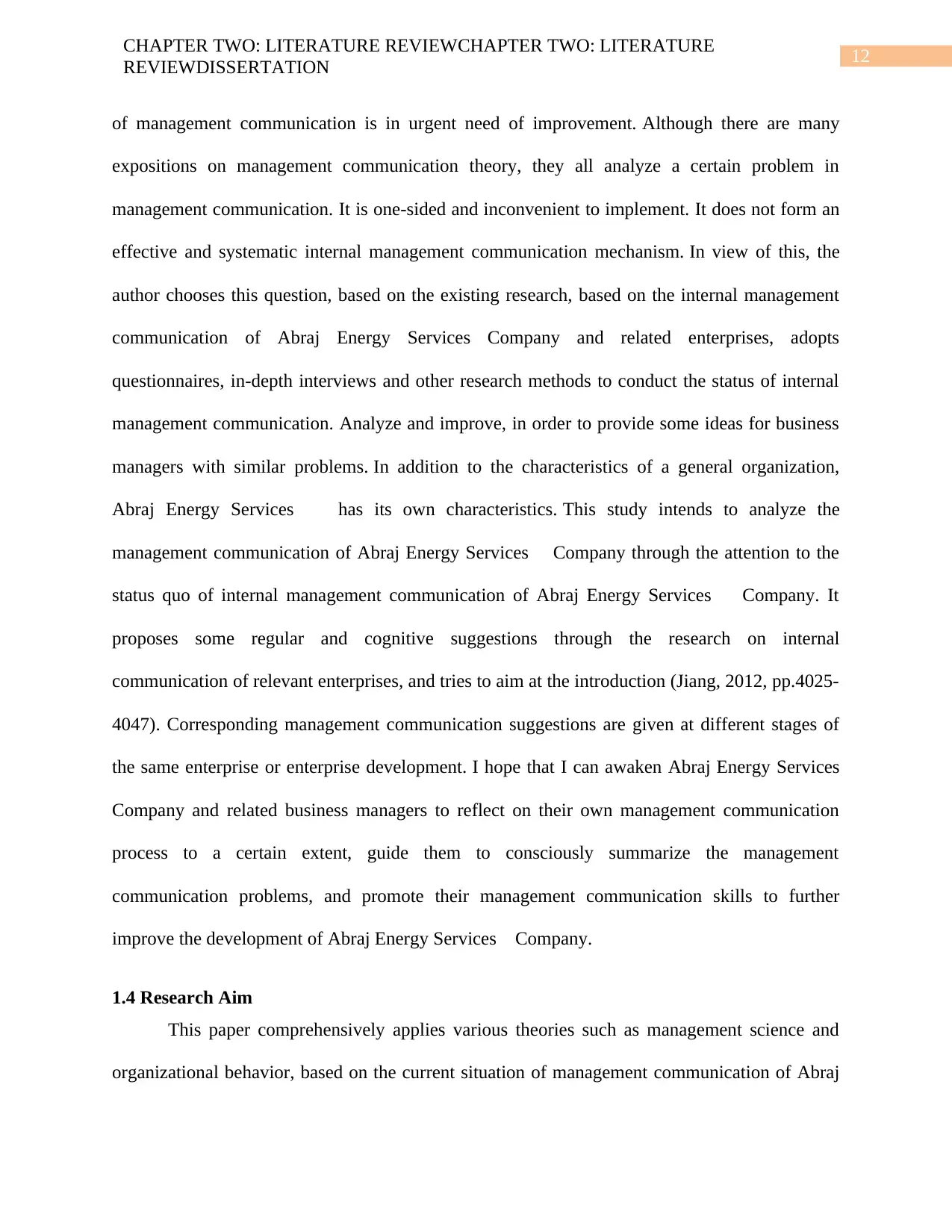
12
CHAPTER TWO: LITERATURE REVIEWCHAPTER TWO: LITERATURE
REVIEWDISSERTATION
of management communication is in urgent need of improvement. Although there are many
expositions on management communication theory, they all analyze a certain problem in
management communication. It is one-sided and inconvenient to implement. It does not form an
effective and systematic internal management communication mechanism. In view of this, the
author chooses this question, based on the existing research, based on the internal management
communication of Abraj Energy Services Company and related enterprises, adopts
questionnaires, in-depth interviews and other research methods to conduct the status of internal
management communication. Analyze and improve, in order to provide some ideas for business
managers with similar problems. In addition to the characteristics of a general organization,
Abraj Energy Services has its own characteristics. This study intends to analyze the
management communication of Abraj Energy Services Company through the attention to the
status quo of internal management communication of Abraj Energy Services Company. It
proposes some regular and cognitive suggestions through the research on internal
communication of relevant enterprises, and tries to aim at the introduction (Jiang, 2012, pp.4025-
4047). Corresponding management communication suggestions are given at different stages of
the same enterprise or enterprise development. I hope that I can awaken Abraj Energy Services
Company and related business managers to reflect on their own management communication
process to a certain extent, guide them to consciously summarize the management
communication problems, and promote their management communication skills to further
improve the development of Abraj Energy Services Company.
1.4 Research Aim
This paper comprehensively applies various theories such as management science and
organizational behavior, based on the current situation of management communication of Abraj
CHAPTER TWO: LITERATURE REVIEWCHAPTER TWO: LITERATURE
REVIEWDISSERTATION
of management communication is in urgent need of improvement. Although there are many
expositions on management communication theory, they all analyze a certain problem in
management communication. It is one-sided and inconvenient to implement. It does not form an
effective and systematic internal management communication mechanism. In view of this, the
author chooses this question, based on the existing research, based on the internal management
communication of Abraj Energy Services Company and related enterprises, adopts
questionnaires, in-depth interviews and other research methods to conduct the status of internal
management communication. Analyze and improve, in order to provide some ideas for business
managers with similar problems. In addition to the characteristics of a general organization,
Abraj Energy Services has its own characteristics. This study intends to analyze the
management communication of Abraj Energy Services Company through the attention to the
status quo of internal management communication of Abraj Energy Services Company. It
proposes some regular and cognitive suggestions through the research on internal
communication of relevant enterprises, and tries to aim at the introduction (Jiang, 2012, pp.4025-
4047). Corresponding management communication suggestions are given at different stages of
the same enterprise or enterprise development. I hope that I can awaken Abraj Energy Services
Company and related business managers to reflect on their own management communication
process to a certain extent, guide them to consciously summarize the management
communication problems, and promote their management communication skills to further
improve the development of Abraj Energy Services Company.
1.4 Research Aim
This paper comprehensively applies various theories such as management science and
organizational behavior, based on the current situation of management communication of Abraj
⊘ This is a preview!⊘
Do you want full access?
Subscribe today to unlock all pages.

Trusted by 1+ million students worldwide
1 out of 99
Related Documents
Your All-in-One AI-Powered Toolkit for Academic Success.
+13062052269
info@desklib.com
Available 24*7 on WhatsApp / Email
![[object Object]](/_next/static/media/star-bottom.7253800d.svg)
Unlock your academic potential
Copyright © 2020–2025 A2Z Services. All Rights Reserved. Developed and managed by ZUCOL.





